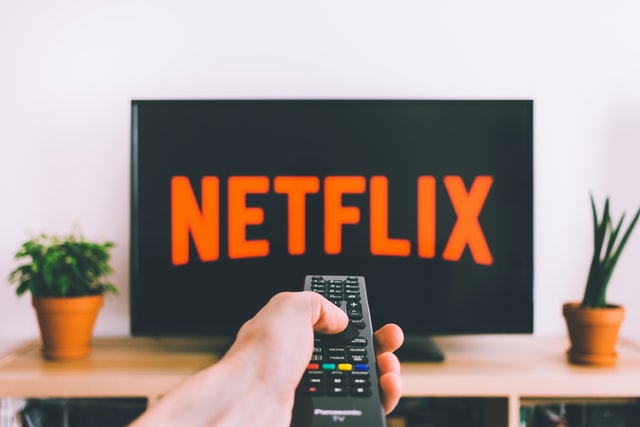A guest post on The Marketing Sage by Barry Enderwick who worked at Netflix in marketing from 2001 to 2012. His insights into Netflix’s marketing strategies and decision-making are fascinating.
I worked in marketing at Netflix for eleven years, so I frequently get asked to have conversations about the Netflix I knew, its transition to what it is doing now, and how it is structured. The undercurrent of these questions is always the same: how can the magic of Netflix’s meteoric success be recreated?
Netflix seems like they can do no wrong.
They were fearlessly expanding internationally, creating some of the most compelling entertainment available anywhere, and being rewarded with continued record share prices and revenues. Who wouldn’t want to replicate that?
But their success is a combination of intelligent decisions based on strategy, timing, and a little luck.
And while timing and luck can’t be replicated, you can learn from their smart strategic decisions. Below are some examples of how this has played out in shaping the Company’s direction and how applying that same lens to company culture enabled its success.
The warning is a long one, so you may want to mark it to read or finish later.
First, What is Strategy?
Strategy is, by definition, “a careful plan or method for achieving a particular goal, usually over a long period.” While many strategies can be deployed, the goal is always to make sure you know where you’re going. Being clear on this point will guide tactical execution and inform what you should and should not do.
Early switch to the subscription model
Early on, Netflix was a portal that also rented and sold DVDs one at a time. That business model was highly replicable and wasn’t going to work. So, they switched to a subscription model that started allowed a specific number of DVDs per month for one fee. Suppose a customer went over that amount they paid more. That lasted less than six months.
Based on data, the Company realized that subscriber growth and customer advocacy would come from an unlimited subscription model. So, the switch was made to unlimited. In making the strategic shift, they found product/market fit and counter-positioned themselves to every competitor in the DVD rental market. If any competitor tried to adopt the subscription model for renting DVDs, it would have severely damaged their core business. Of course, it didn’t hurt that the leading competitor, Blockbuster, dismissed the business model as a niche.
Takeaway: Having a strategy not only provides long-term direction, but the right one can also be used to thwart possible competition.
Brand
When I started at Netflix in 2001, the brand position was “The best way to rent DVDs.” As brand positions go, it was functional at best. We had been moderately successful in marketing the service with a few different messages. But we had no real foundation for generating future messaging and not a clear understanding of what we needed to be for the consumer to consider our offer.
Around 2004, we conducted research, distilled it down, and came to the position, “Movie enjoyment made easy.” From that point on, everything had to pay off that position. It was the research-driven foundation we needed to continue creating marketing messaging and aligning how we thought about features, envelope designs, etc.
Takeaway: A well-researched brand position provides strategic guidance for everything the Company does.
Getting the jump on the streaming
Until around 2004, the Company’s strategy was to grow and be the biggest DVD rental company in the world. However, increasing Internet speeds signaled to us that streaming was eventually going to be the way to deliver entertainment. But streaming lowered the barriers to entry for the competition.
Our strategy shifted to “get big on DVD, then transition to streaming.” The idea is that we create momentum such that we would already have a substantial installed base of customers by the time competition showed up. Remember, this was a full four years before we would even launch the very sparse library of titles as a free add-on to the beloved DVD-by-Mail service.
Takeaway: Obviously, no one can predict the future. But shifting strategy to anticipate or react to market changes means you won’t get caught opting for a short-term gain that sinks your long-term goals.
The Netflix Box (photo courtesy of friend and former co-worker Joel Sass)
Killing the Netflix Box
In 2007, we were so far down the path with the Netflix branded streaming device that we were shooting promotional videos for it to have on the site. It was a done deal. Then the hand brake was pulled — and complicated. The decision to stop something we had spent so much time and money on was not easy. But it was the right thing to do. The Company didn’t focus incessantly on sunk costs- with new information and views, the future is what matters to Netflix, not the past.
Our strategy was to have Netflix on every device capable of connecting to the Internet. To do that, we would have to convince major brands like Samsung, Microsoft, and Sony to include Netflix on their Blu-ray players, game consoles, and streaming devices.
Getting on all the boxes would give us a first-mover advantage and ubiquity, giving us a tremendous head start on the competition. Netflix launched a box.
The purpose was proof of concept to get manufacturers on board and have a streaming device for consumers. Though we had an in-house team developing hardware and software for the prototype, we had no experience launching and scaling such a device.
Enter Anthony Wood, CEO of Roku, who was hired to lead this effort. But then the realization came. If our goal were to be on all devices, why would we compete with them by getting into the hardware business? The decision was made. Kill the Netflix Box instead of killing our strategy. And even though the Netflix Box was killed internally, it did see the light of day as the Roku Player.
Takeaway: In strategy, knowing what not to do is just as important as knowing what to do. And it is always a good idea to gut-check decisions along the way. Even if it comes at a short term-pain, reversing a decision to align with the long-term strategy for the bigger payoff is the right thing to do.
Original Content
The original content hits “House of Cards” and “Orange Is the New Black” were not the first foray into original content for Netflix. Back in 2006, Red Envelope Entertainment was launched by Netflix to make movies that didn’t have distribution and get them in front of members who would value them. But the timing was off. Our strategy at the time was to “get big on DVD, then transition into streaming.” Original content is expensive. At the time, were we to pursue original content, the money would have had to come from somewhere else in the Company, and it just didn’t pencil out.
Plus, our content partners didn’t exactly appreciate the competition of us purchasing content.
Fast forward to 2011, when Netflix launched its original content. The Company stated that the goal was to become more like HBO before HBO could become more like Netflix. While that was true, it only tells part of the story of why the decision to create original content was so strategically brilliant.
Until around 2011, we had to build a brand around Netflix, the service, because all we had was others’ studio and network content. We were marketing Netflix as a service – NaaS. But in a world where Netflix was competing for the same pool of content, they were going to be quickly outspent by those with deeper pockets like Amazon or YouTube. With original content, Netflix had a point of differentiation, fulfilling the HBO comparison above. But there’s more.
Retention
Netflix knows how to use viewing data to provide more value. For over a decade, they’ve been refining their recommendation process that surfaces movies and TV shows to their members, which does just that. When they decided to create originals, they could leverage the same data to make “smart bets.”
Ok, that’s not fair because they’re not bets at all.
They’re very well-informed investments. It’s why no creator must shoot a pilot and why Netflix doesn’t use focus groups for any content. They have confidence in their data-based decisions Note: it isn’t all machine learning, there is a deep understanding of actors, directors, and Hollywood by Ted Sarandos, Cindy Holland, and everyone else on the content team. This matters significantly as data will only get you so far.
By surfacing the right content from other sources, including recently watched items, and making the right original content, they provide even more value. More value equals higher retention. Add in the tidal wave of quality entertainment and the frequency in which it’s released, and it turns out to be an impressive retention play.
International Expansion
But the volume and frequency of original content payout in another way, too — international expansion. I participated in a lot of in-country international market research to help determine likely success. I can confidently say that there are countries that Netflix has announced they are going into now or soon that would have been entirely unprofitable under our NaaS model. And I mean, guaranteed unprofitable.
Take South Korea, for example. Piracy is commonplace and accepted there. People load up credits using their credit card and download TV shows and movies. Even movies still in the theatre (for only a couple of dollars, too) are available.
It isn’t super easy because you must search for it, but it isn’t hard. Without original content, Netflix would have marched in with older content that would have been readily accessible should anyone want to see it. No one we talked to was interested.
The only thing different between then and now? Original content. Of course, the actual content is layered on top of a unique, established brand with excellent service, an unbelievable UI, and a ridiculous value proposition. Still, the thing that puts them over the top is the original content.
In South Korea, the introduction of Netflix Originals suddenly offers a non-stop, high-volume stream of high-quality original content exclusive to the platform. Technically it can be pirated. But if the massive files aren’t enough of a deterrent, the sheer volume, and frequency of original content being churned out by Netflix render piracy more trouble than it’s worth for most consumers.
Redefining What a “Hit Show” Really Is
To be sure, the analysts and external observers were impressed by the splash that “House of Cards” made. Suddenly, this Company had never made original content taking on the grandfather of original content, HBO. And Netflix nailed it. House of Cards was a huge success and ubiquitous. Even politicos continue to talk about it.
Fast on the tail of that, they had another big hit in Jenji Kohan’s “Orange Is The New Black.” And expectations were set.
Now some analysts maintain that Netflix will be no better or worse at creating successful content than anyone else. But thinking that what has always defined a “hit” still holds is misguided. Those analysts would do well to think more contextually about what defines a hit now, especially for Netflix. For them, a collision does not have to be a House of Cards level success.
There are no Neilson/Arbitron ratings to worry about. It merely must succeed in engagement metrics for the intended audience. “Sense 8″ or” Marco Polo” does not have to be talked about in People magazine like “House of Cards” was. It must engage the members who would likely love it — the fans of the genre, actor, or director.
This success metric has two intrinsically intertwined facets — retention and acquisition. If the TV show or movie succeeds with the existing members, it boosts retention. But it also turns those members into evangelists. And you can be sure there is a proxy in the great big pool of non-members that will sign up based on this word of mouth from the newly minted evangelists. It was that way with content created by others, and you can be sure it is that way with Netflix-created content. Sci-fi fans may not trust People magazine to tell them about new, exciting titles, but they will believe like-minded members were talking up the latest sci-fi series from Netflix.
Takeaway: Making a timely strategic shift can have multiple payouts.
Company culture
One of the reasons I liked Netflix was that when I was interviewing for my role there, I learned that employees had to buy their snacks and soda. Also, the headquarters was in a “beat-down” building. Compared to the excesses of dot-com culture that were imploding all around Silicon Valley in 2001, this was a clear signal that the money they had was going exclusively toward growing the business and not wacky perks.
Still, when I first started at Netflix, culture did not exist explicitly.
But still, there was no deliberate, published, purposeful strategy for culture in place. Then came the “high-performance culture.” It was a bit frightening at first because it was such a massive departure from typical company culture as it existed then.
Chief Talent Officer Patty McCord, and CEO Reed Hastings, spearheaded this change and the employees helped refine what it meant. Processes were stripped away, and ultimately what emerged was a culture in which one was trusted to be a responsible adult. Which also meant you had to make your own decisions. And live with the results, for better or worse. This was all codified in the slide deck, but by the time it was shared with the world, we had been living it for over five years.
Not long after it impacted the hiring process (which happened quickly), it started to make a real difference. As more and more people could focus on the role they were hired for, the more efficient and innovative we became. Everything from content to IT, engineering to marketing, we all started thriving.
Quick aside, much has been made about the “no vacation” policy. To understand how this came about, you have to read the deck above or listen to Patty McCord discuss how her approach to HR was to strip away policies and processes that only served to sap the time and energy of employees. Rather than track hours, approvals, etc., they just did away with it all. And it fits in with the rest of the “high-performance culture.”
A company adding benefits like this without the other having the other aspects of company culture in place is a recipe for disaster for various reasons. For more, here’s a great read on why copying company culture, or even merely aspects from it, is not a good idea.
The customer at the center
At Netflix, everyone was relentlessly focused on the consumer (members, non-member, and rejoins). We had our department in-house that led all qualitative and quantitative research. At any given time, everybody from admins to C-suite execs was behind the glass listening to consumers. And the study was constantly shared within the Company. In fact, at company meetings, aside from Reed’s wrap-up, there were only two permanent spots reserved. One for Finance and one for consumer research. That says a lot about how strategic consumer input was to the Company.
Takeaway: Strategic thinking applied to company culture provides clarity for everything from hiring to policy development and can lead to impressive gains.
You get the idea
The Netflix strategy is unlimited, low-cost subscription. It’s an easy-to-understand consumer proposition. And until recently, if any of the business competitors listed above tried to offer the same thing, it would have seriously damaged some if not all of their revenue streams.
The only competitor that has a similar product offering from a consumer standpoint is HBO. But they don’t have the data chops Netflix has when it comes to creating originals. Yes, Amazon and HBO can develop the means to develop original programming in the future since they have a direct pipeline allowing them insight into consumers’ viewing habits. But the fact that Amazon still does “pilots episodes” is telling.
Takeaway: A clear strategy for your offering allows for clear consumer understanding and adoption. It can also help guide pricing structure, product/feature development, and more.
So, They’re Perfect Then?
No. As they grow, so too do the complexities from the Company having to hire more and more people, which introduces managerial layers, to the increasing number of original titles that will continue to eat more significant portions of the budget. Layer in creating locally relevant, in-language content, and you can see that they will need dollars.
It’s estimated that they have over $10 billion in content liabilities over just the next five years. And to keep things rolling, they’ve already taken on additional debt (albeit at a meager cost). But low-cost money may not be available forever. Also, their big splash of a debut benefitted from the “first-mover advantage.” The novelty of which is now starting to fade. With everyone else starting to make original content, they will have to keep it up.
And if you remember the Qwikster debacle, then you know they aren’t perfect.
Despite all of that, the downturn so many analysts have been betting on over the last couple of years hasn’t materialized. That’s due, in part, to the goodwill Netflix has generated by continuing to grow year-over-year. That content liability is being plowed back into the business to create the original content fueling their growth.
You can see why I think that Netflix is THE global leader in streaming entertainment. That didn’t happen by accident. It’s a combination of innovation, strategic thinking, and, to be fair, a little luck. Copying that exactly would be impossible.
I should note, I have no financial stake in Netflix, nor am I affiliated with them any longer. This is written based on my experience and analysis.

Barry W. Enderwick – Brand/marketing executive, former Netflix, MZ. I write on startups, strategy, business, culture & design. Also on Instagram @craftbarry @inthechipswithbarry
Photo by freestocks on Unsplash




